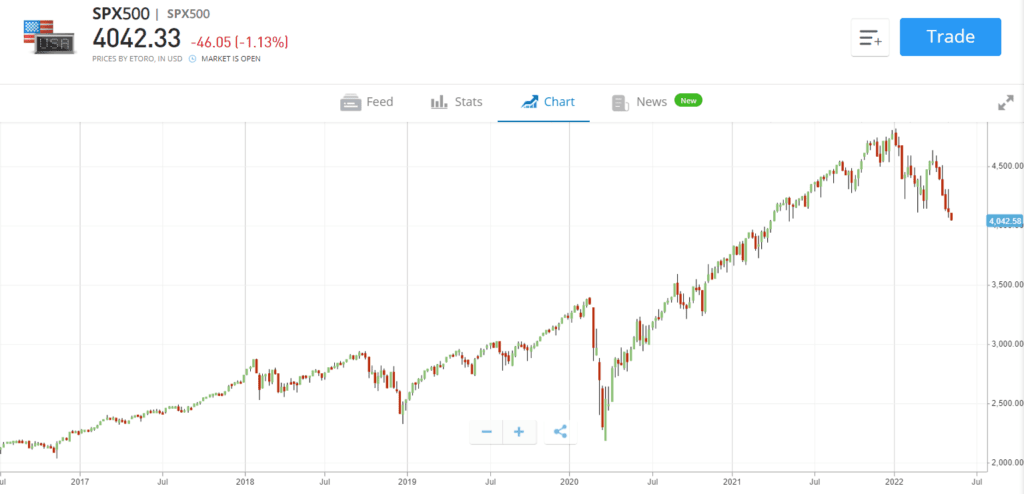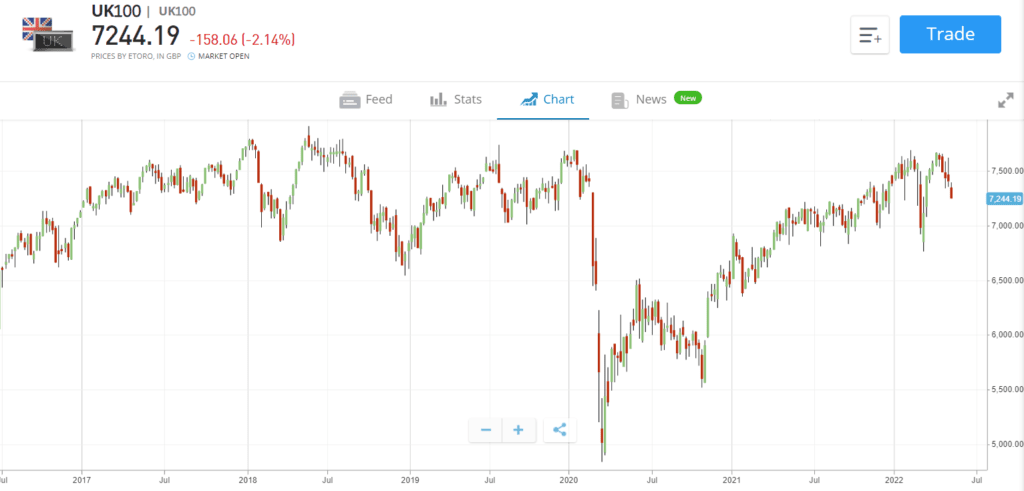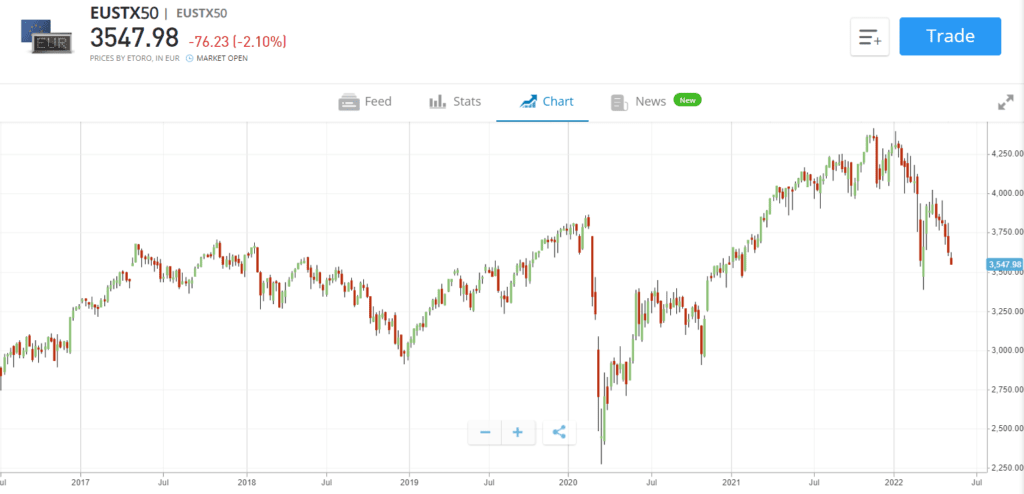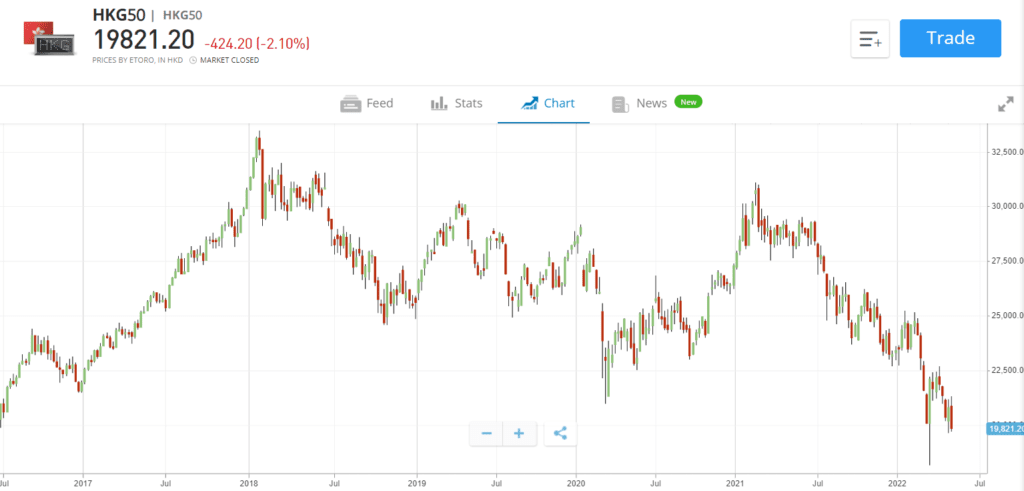This content is intended for information and educational purposes only and should not be considered financial product advice or any recommendation.
2022 has been a good year for those who like to trade stock market indices so far. With major indices such as the S&P 500, the Nasdaq 100, and the FTSE 100 all experiencing high levels of volatility, there have been plenty of opportunities for traders.
Volatility has created trading opportunities in 2022
In the US, the S&P 500 index (SPX500) has experienced a ‘correction’ this year after several years of strong gains. After starting the year at 4,766, the index has fallen below 4,200 recently amid concerns about inflation and interest rates, and underwhelming results from major index constituents such as Amazon and Alphabet. These numbers don’t tell the full story though. At times in 2022, the S&P 500 has staged some strong rallies. Meanwhile, between the start of the year and the end of April, the index posted daily gains or losses of 2% or more on 12 occasions. In 2021, it only registered seven of these 2%+ moves for the whole year1.
As for the tech-focused Nasdaq 100 index (NSDQ100), it has underperformed the S&P 500 as rising interest rates have put valuations in focus. In April, it had its worst month since 2008, falling 13.3%2. However, like the S&P 500, it has had periods of strength at times this year. In the second half of March, for example, the index surged more than 10%.
European equities, as measured by the Euro Stoxx 50 index (EUSTX50), have also struggled in 2022. This index broke down in the second half of February amid tension between Russia and Ukraine. Investors were concerned that a war between the two countries would have wide-ranging repercussions for the European economy, from rising food and energy prices to sanctions impacting trade and investment. The index enjoyed a bounce in March, but has since trended lower.
However, the UK’s FTSE 100 index (UK100) has held up well in 2022. It has been helped by its exposure to the energy sector and defensive dividend stocks. It has still had big swings at times though. In March, it declined from near 7,500 to below 6,800 in the space of a few trading sessions before staging a rapid recovery back above 7,500.
In Asia, Hong Kong’s Hang Seng index has been an underperformer in 2022. It has been impacted by a number of factors including regulatory developments, Covid-19, and slowing economic growth in China. There have been periods of strength, however. In mid-March, for instance, the index spiked higher after China’s State Council vowed to stabilise the markets. Japan’s Nikkei 225 (JPN225), by contrast, has been a relative outperformer. It’s still down for the year. However, it has held up better than US and European indices, boosted by accommodative monetary policy from the Bank of Japan and a weaker Yen, which has helped exporters.
4 stock market indices to watch in Q2
Looking ahead, stock market indices are likely to see further volatility in the near term. Right now, there are a myriad of factors that have the potential to impact share prices including the Russia-Ukraine crisis, inflation, central banks’ actions, commodity prices, supply chain issues, Covid-19, and slowing economic growth. So, index traders are likely to continue to see opportunities, both on the upside and the downside. With that in mind, here’s a look at four major indices to watch in Q2.
S&P 500 (SPX500)

Past performance is not an indication of future results.
- The main factor driving the S&P 500 index right now is the US Federal Reserve’s actions.
- In an effort to bring down inflation in the US – which hit its highest level since 1981 in March3 – the Fed is raising interest rates aggressively. In early May, the central bank raised rates by 0.50% to a range of 0.75% to 1.00% after lifting rates by 0.25% in March. The futures market is pointing to a Fed funds rate of 2.85% by the end of the year4.
- Where the Fed goes from here in terms of rate hikes (and investors’ views on whether the central bank can engineer a ‘soft landing’ and avoid a recession) could have a major impact on the S&P 500 in the short term.
- If the Fed continues to raise rates aggressively, the S&P 500 could trend lower. In this scenario, mega-cap tech stocks with above-average valuations, such as Apple, Alphabet, and Nvidia – which make up a large proportion of the index – may underperform, putting pressure on the index.
- However, if inflation starts to fall, and the Fed takes its foot off the pedal and eases its rate-hike schedule, US equities could regain some upward momentum. The next Fed meeting is 14-15 June. We are likely to see some volatility around these dates.
- While the S&P 500 has already fallen significantly this year, some analysts believe there’s more downside on the cards. Morgan Stanley’s Chief US Equity Strategist Mike Wilson, for example, believes the index could fall 8% to 16% from its level at the end of April (4,132). Wilson believes the index could hit 3,460 if a true growth scare is on the cards5.
- “We think the S&P 500 has minimum downside to 3,800 in the near term and possible as low as 3,460, the 200-week moving average if forward 12 month EPS start to fall on margin and/or recession concerns,” he wrote in a research note recently.
- However, Wilson also noted that any good news could lead to a “vicious bear market rally” for the S&P 500, as he believes the market is currently very ‘oversold’. So, we could still see upside here in the near term.
FTSE 100 (UK100)

Past performance is not an indication of future results.
- The FTSE 100 index has been a top performer on a relative basis this year, outperforming the S&P 500, the Nasdaq 100, and the Euro Stoxx 50.
- One reason it has outperformed is that oil giants Shell and BP are among its top 10 holdings. The share prices of these two stocks are up double digits this year on the back of high oil prices. The FTSE 100 also has a number of defensive dividend stocks among its top 10 constituents including GlaxoSmithKline, AstraZeneca, and Diageo. These stocks have held up well in the recent market turmoil.
- Looking ahead, there are several factors that could have an impact on the Footsie in the near term. One is oil prices. Higher oil prices could boost the index, while lower prices could impact it negatively. In the short term, the price of oil is likely to depend on the Russia-Ukraine crisis and whether we see a resolution to the conflict.
- Another factor that could impact the FTSE 100 is recession fears. While the index is home to a number of defensive stocks, it also contains plenty of cyclical stocks such as Lloyds Bank, HSBC, and Barclays. If the chances of a recession increase, these bank stocks could underperform and drag the index down. In early May, the Bank of England warned that the UK is likely to fall into a recession this year as inflation squeezes household income6.
- The strength of the pound is another issue to consider. The FTSE 100 contains many multinational companies that generate income internationally. When the pound falls, these companies’ international earnings are worth more in GBP terms. This tends to push their share prices up. This year, the pound has fallen as the US dollar has strengthened. Where it goes from here is likely to depend on economic conditions in Britain and interest rates.
Euro Stoxx 50 (EUSTX50)

Past performance is not an indication of future results.
- The Euro Stoxx 50 index has been significantly impacted by the Russia-Ukraine crisis this year. Investors have been concerned that the war will have severe economic consequences for Europe.
- Looking ahead, inflation could be a key driver of index returns. In March, eurozone inflation hit a record 7.5%7. Natural gas prices are partly to blame for this elevated level of inflation. Europe typically gets about 40% of its gas from Russia, and fears over a major shortage have pushed prices to sky-high levels.
- If inflation remains high, it could weigh on both business and consumer spending across Europe, impacting economic activity. This would not be good for the Euro Stoxx 50 as the index has considerable exposure to cyclical stocks. Industrials, Chemicals, Banks, and Automakers make up around 35% of the index8.
- Europe is less likely to feel the effects of high gas prices over the warmer summer months, however. This should allow for some breathing room on the inflation front.
- In the short term, the Euro Stoxx 50 is also vulnerable to supply chain issues arising from the Russia-Ukraine crisis and Covid-19 disruption in China. One company that could be impacted here is semiconductor equipment manufacturer ASML, which is the largest constituent in the index with a weighting of around 8%9. Automakers such as BMW, Mercedes-Benz, and Volkswagen could also be impacted. These companies make up about 5% of the index10.
- One thing in the Euro Stoxx 50’s favour is its valuation. At the end of April, the average trailing price-to-earnings (P/E) ratio across the index was about 1511, versus around 24 for the S&P 50012. If investors seek out value stocks in the months ahead, the index could benefit.
Hang Seng (HKG50)

Past performance is not an indication of future results.
- Hong Kong’s Hang Seng index has had a poor run in 2022, and is currently well below its 2021 highs.
- In March, the index slumped on the back of concerns over the Russia-Ukraine war and worries that Chinese stocks could be delisted from US exchanges. More recently, a resurgence in Covid-19 cases has impacted the index, as it has clouded the economic outlook for China.
- Looking ahead, Covid-19 could have a major impact on the index. China has implemented a ‘zero-Covid’ policy, which has resulted in lockdowns across the country. This is likely to impact economic growth, not only in China, but also internationally. Recently, the International Monetary Fund (IMF) reduced its 2022 growth forecast for China to 4.4% from 4.8%13.
- If we see some positive developments in relation to China’s Covid-19 restrictions, the index could get a boost. If the situation deteriorates, however, Chinese equities may continue to fall. Some analysts believe the situation could get worse before it gets better.
- Regulatory action is another issue that could impact this index. Recently, the US Securities and Exchange Commission (SEC) added over 80 Chinese firms14 to its list of entities facing possible expulsion from American exchanges, including JD.com. Further negative developments in this space could hit share prices.
- Regulatory developments could also have a positive impact on Chinese stocks, however. Over the last year, Chinese tech shares such as Alibaba, Meituan, and Tencent have fallen as Chinese regulators have cracked down on dominant technology companies. Yet recently, regulators have signalled that they may ease their crackdown on the tech giants in order to support the economy. This could remove one source of downward pressure on the index.
- After recent share price falls, many Chinese stocks now look cheap. For example, Tencent currently trades at around 22 times this year’s forecast earnings while Alibaba trades at just 13 times this year’s expected earnings. Given these low valuations, we could potentially see a sharp rebound from the index if sentiment towards Chinese equities improves.
Charts sourced from eToro platform 09/05/2022.
References
2https://finance.yahoo.com/video/nasdaq-sees-worst-month-since-133406039.html
3https://tradingeconomics.com/united-states/inflation-cpi
6https://www.ft.com/content/5001ffb8-96d6-4e1a-a9dc-5ad4470930c7
7https://www.politico.eu/article/eurozone-inflation-soars-to-record-7-5-percent-in-march/
8https://www.stoxx.com/document/Bookmarks/CurrentFactsheets/SX5GT.pdf
9https://www.stoxx.com/document/Bookmarks/CurrentFactsheets/SX5GT.pdf
10https://www.stoxx.com/document/Bookmarks/CurrentFactsheets/SX5GT.pdf
11https://www.stoxx.com/document/Bookmarks/CurrentFactsheets/SX5GT.pdf
12https://www.spglobal.com/spdji/en/indices/equity/sp-500/#overview
13https://www.reuters.com/world/china/imf-chief-warns-risks-prolonged-china-slowdown-2022-04-21/
eToro is a multi-asset platform which offers both investing in stocks and cryptoassets, as well as trading CFDs.
Copy Trading does not amount to investment advice. Your investments value may go up or down. Your capital is at risk.
eToro AUS Capital Limited ACN 612 791 803 AFSL 491139. OTC Derivatives are leveraged financial products and considered speculative. OTC Derivatives may not be suitable for all investors. You don’t own the underlying assets. You risk losing all of your investment. This information is general only and has been prepared without taking your objectives, financial situation or needs into account. Consider our Product Disclosure Statement and Target Market Determination (PDS and TMD). See full disclaimer.
This communication is for information and education purposes only and should not be taken as investment advice, a personal recommendation, or an offer of, or solicitation to buy or sell, any financial instruments. This material has been prepared without taking into account any particular recipient’s investment objectives or financial situation, and has not been prepared in accordance with the legal and regulatory requirements to promote independent research. Any references to past or future performance of a financial instrument, index or a packaged investment product are not, and should not be taken as, a reliable indicator of future results. eToro makes no representation and assumes no liability as to the accuracy or completeness of the content of this publication.